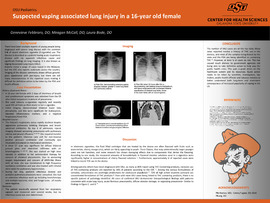| dc.contributor.author | Febbraro, Genevieve | |
| dc.contributor.author | McCall, Meagan | |
| dc.contributor.author | Bode, Laura | |
| dc.date.accessioned | 2020-05-05T19:37:38Z | |
| dc.date.available | 2020-05-05T19:37:38Z | |
| dc.date.issued | 2020-02-28 | |
| dc.identifier | ouhd_febbraro_suspectedvapingassociated_2020 | |
| dc.identifier.citation | Febbraro, G., McCall, M., & Bode, L. (2020, Feb. 28). Suspected vaping associated lung injury in a 16-year old female. Poster presented at Research Day at Oklahoma State University Center for Health Sciences, Tulsa, OK. | |
| dc.identifier.uri | https://hdl.handle.net/11244/324189 | |
| dc.description.abstract | Background: In the summer of 2019, there were multiple reports of young people falling ill, diagnosed with a severe lung disease without any apparent infectious cause after extensive radiographic imaging studies and laboratory tests. The common link being history of recent electronic cigarette (e-cigarette or vaping) use. This new illness is defined as Vaping Associated Lung Injury (VALI) and is affecting young people in the United States. Multiple early studies involving vaping and lung injury show a pattern of diffuse lung injury on imaging and severe respiratory symptoms leading to respiratory failure and even death in some cases. | |
| dc.description.abstract | Case Presentation: A 16-year old female with worsening bilateral pneumonia failing outpatient treatment presented to the pediatric emergency center. The patient was hypoxic on presentation requiring supplemental oxygenation. History was significant for regular and recent e-cigarette use—including recent use of illicit tetrahydrocannabinol (THC) in her e- cigarette. She was initially treated on the general pediatric floor with pulmonary toileting and broad-spectrum antibiotics. She rapidly declined requiring intensive care admission for BiPAP and eventually intubation with mechanical ventilation and escalation to high frequency oscillatory ventilation. Infectious disease and pulmonology specialist were consulted for a comprehensive infectious work up which ultimately was negative. Imaging, including chest x-ray and chest CT consistently showed diffuse bilateral interstitial and ground glass infiltrates. With extensive supportive care, patient eventually improved and infectious work up did not yield any positive results. | |
| dc.description.abstract | Conclusions: Every single day, the number of reported cases of VALI increases with more questions arising about the cause and how to get a handle on the situation. Since this study, new information has emerged as to the cause including excess levels of vitamin E and illicit THC vaping cartridge operation originating in the mid-west. Quick action needs to be taken by scientist, investigators, law makers, public health officials, and the tobacco industry to better understand the long-term and short-term consequences of the increased popularity of vaping in the United States. | |
| dc.format | application/pdf | |
| dc.language | en_US | |
| dc.publisher | Oklahoma State University Center for Health Services | |
| dc.rights | The author(s) retain the copyright of have the right to deposit the item giving the Oklahoma State University Library a limited, non-exclusive right to share this material in its institutional repository. Contact Digital Resources and Discovery Services at lib-dis@okstate.edu or 405-744-9161 for the permission policy on the use, reproduction or distribution of this material. | |
| dc.title | Suspected vaping associated lung injury in a 16-year old female | |
| osu.filename | ouhd_febbraro_suspectedvapingassociated_2020.pdf | |
| dc.type.genre | Presentation | |
| dc.type.material | Text | |
| dc.subject.keywords | vaping | |
| dc.subject.keywords | e-cigarettes | |
| dc.subject.keywords | pulmonary disease | |
| dc.subject.keywords | lung injury | |
